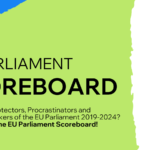CAN Europe and WWF welcomed today’s final approval by EU ministers for the “backloading” measure that will temporarily withdraw 900 million pollution permits from the EU Emissions Trading System (ETS). After almost a year and a half of wrangling, the temporary “quick fix” for the glut of permits on the EU’s carbon market finally nears implementation with EU Member States backing the measure by an overwhelming majority.
“The final approval of the carbon-market fix is a step in the right direction but it is only a patch up solution. These toxic permits will now hang as the sword of Damocles over the EU ETS and risk causing a second carbon price crash if they return to the carbon market,” said Sam Van den plas, Climate Policy Officer at WWF. “What we need is structural reform measures for the EU ETS that include a supply mechanism to remove pollution permits from the market permanently before 2020.”
The backloading measure will delay from auction 900 million pollution permits, which will return to the market before 2020. Putting this number in perspective, at the end 2012 the total surplus accumulated on the EU’s carbon market reached almost two billion.
“The oversupply of pollution permits remains a ball and chain for EU climate ambition and a threat to environmental integrity of the upcoming climate and energy package,” said Julia Michalak, EU Climate Policy Officer at CAN Europe. “Any new proposals for EU climate policy will be seriously undermined without deep ETS reform.”
The European Commission is scheduled to publish proposals for structural reform of the EU ETS and a climate and energy policy framework for 2030 in mid-January. The EU must provide the signals needed for investor confidence to help the EU stay on the road to decarbonisation.
In order to revive the EU ETS, CAN Europe and WWF are calling for permanent removal of at least 2.2 billion allowances before 2020 and an increase in the annual emission reduction trajectory to at least 2.6%. The next climate and energy package must include ambitious, binding targets of at least 55% greenhouse gas emission reductions, 45% renewable energy and 40% energy savings by 2030.
NOTES:
Why must the ETS be fixed?
– The EU ETS is currently not functioning as envisaged. The scheme is neither contributing in a cost-effective manner to the EU’s climate objective of 80-95% emission cuts by 2050, nor accelerating the required low-carbon transition, and is therefore failing to meet its principal policy objectives.
– With back-loading and ETS structural reform in place, auctioning revenues for all Member States would increase significantly between 2014 and 2020. With the right policy choices, these funds can mobilise investments in clean and resource-efficient technologies in the power sector and industry as a whole.
– A restored carbon price signal will accelerate the modernisation of the power sector especially in central and eastern European Member States, which are obliged to invest the monetary value of the free allowances in the upgrade of their power systems.
– Back-loading will not decrease Europe’s competitiveness. In addition to a 100% free allocation of allowances, industrial sectors supposedly at greater risk of ‘carbon leakage’ (the flight of carbon intensive industries to lesser regulatory regimes) – such as steel, cement and glass production – may receive state aid in compensation for increased electricity prices resulting from CO2 costs passed on by power producers. Back-loading will not decrease the surplus of allowances held by many companies.


